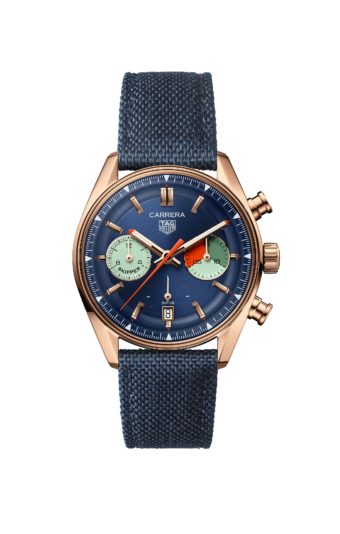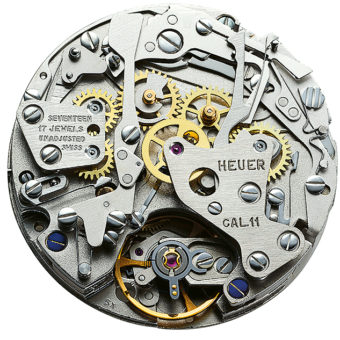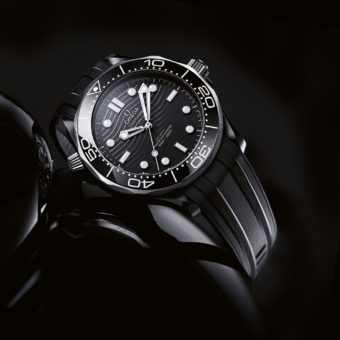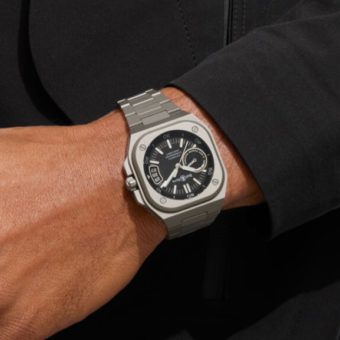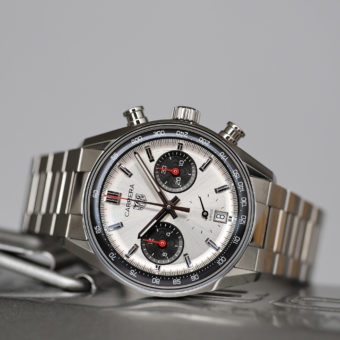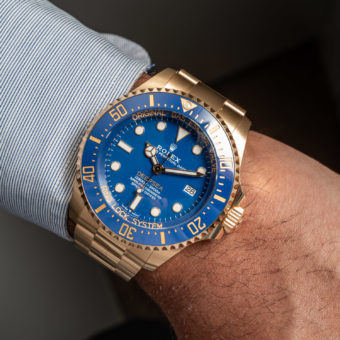This article was originally published in the September/October 2022 Issue of the WatchTime print magazine.
There are some watches that are loved by their fans even more than by their manufacturers. Until recently, this situation was true for the Autavia, at least for most of the 60 years since its first appearance. The face of the TAG Heuer brand has long been defined by the Carrera as well as by the Monaco. Like the Autavia, both models stand for chronographs and motorsports. Different lines filled the third place in the collection over the years, at least since the Autavia was discontinued in 1985. In the 1990s, it was the avant-garde Kirium and the Link, followed by a brief revival of the Monza shortly thereafter. Later, focus shifted to the Aquaracer dive watch and the Formula 1, which attracted younger customers. More recently, the brand has been promoting the Connected smartwatch launched in 2015. If you go to the Collections overview on the TAG Heuer website, you’ll find the Connected at the top and the Autavia in sixth place (out of a total of seven).
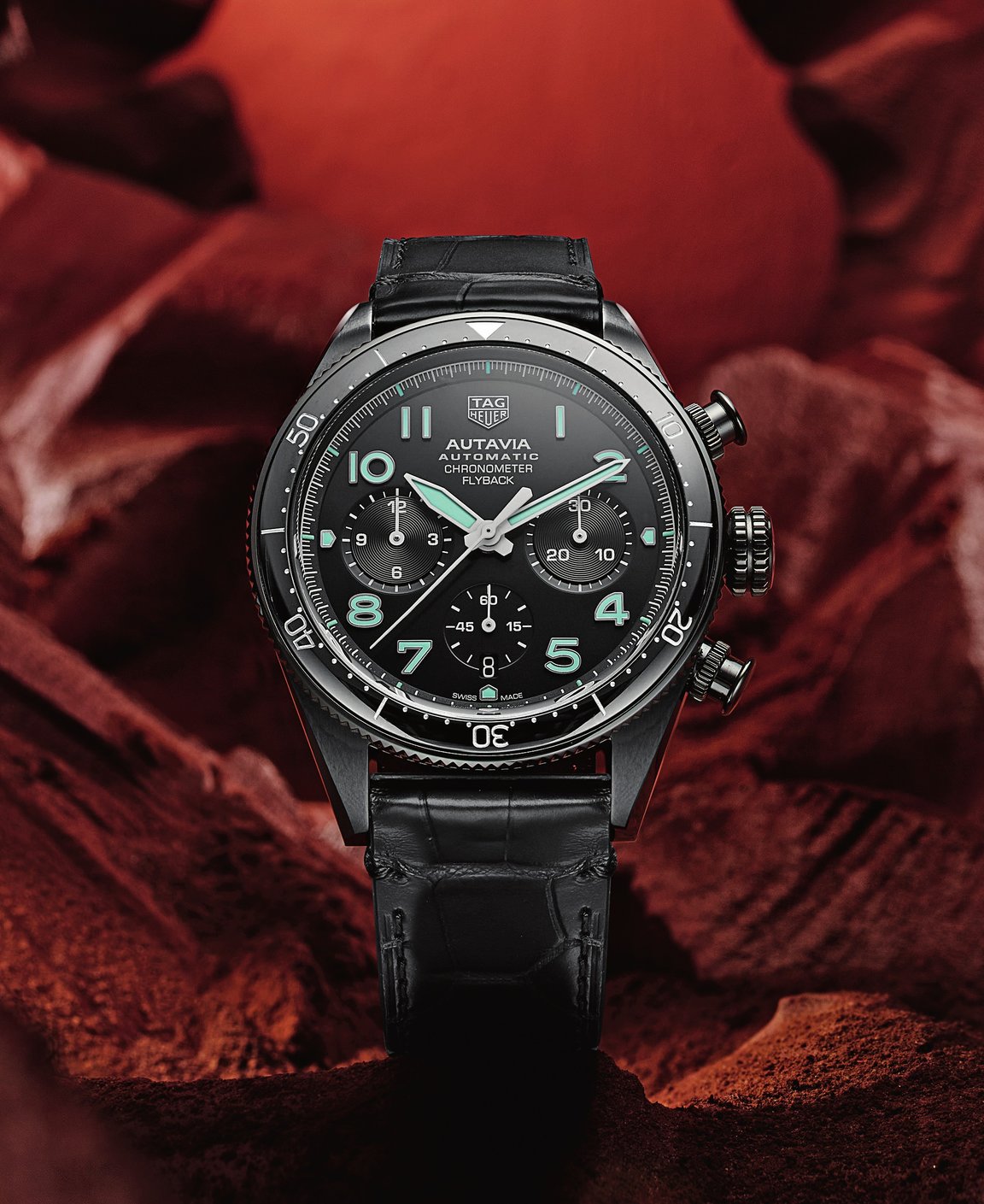
In 2017, the Autavia experienced a highly regarded revival as a chronograph whose design was closely based on a historical model, only to reappear in 2019 as a three-hand watch with a new and distinctive design. This caused a certain amount of confusion. But now, on its 60th anniversary, it is back as a flyback chronograph and a GMT watch, which reconciles the 2019 design with historical precedent.
In collectors’ circles, things looked very different over the years. Here, the Autavia has been considered one of the “Big Three,” alongside the Carrera and the Monaco, and has consistently been a source of excitement. There are a variety of reasons for this. Above all is its close connection to Formula One and its history, and its charismatic drivers of the 1960s and ’70s. In addition, the classic Autavia offers collectors a broad range of designs: rotating bezels in various widths and fonts, a variety of different colored dials with three or two subdials, larger and smaller case sizes, as well as all kinds of bracelets and straps. And last but not least, the quality of the older Autavias is so high that you can still enjoy them even decades after they were made. The Autavia embodies a time, just before the oil crisis of 1973, that was defined by a heady optimism about the future and an unadulterated trust in science and progress. The dynamic creativity of the young Heuer boss was also part of this time. Jack William Heuer, born in 1932 and great-grandson of the company’s founder, unexpectedly purchased the majority of shares in the family’s company and thereby prevented its planned sale to Bulova. At age 28, Jack Heuer was brimming with ideas on how to adapt the company and its product portfolio to the new era.

In the early 1960s, the Heuer brand was primarily known as a manufacturer of stopwatches. Jack Heuer placed his focus on wristwatches instead, and chronographs, in particular. The Autavia was the first watch he created, in 1962. He took the name from a Heuer cockpit instrument introduced in 1933, which had been installed in airplanes as well as automobile dashboards. Because of its dual purpose, it was given the name Autavia, a combination of “automotive” and “aviation.”
The new Autavia had little in common with the chronograph dials from the 1940s and ’50s, which often appeared overloaded and combined a coiled tachymeter track in the center of the dial with telemeter and/or pulsometer tracks at the edge. Jack Heuer designed his first chronograph to meet the needs of professionals — simple to use and easy to read. And then the first watch arrived: the 2446, in a large case for its time, measuring 39 mm. Its three large, white subdials were almost touching and at the same time, clearly stood out from the black background. Aside from the 12, there were no numerals for the hours, just line markers which, like the hands, were filled with luminous paint so they were easy to read even in the dark, as well as the triangle marker on the ratcheting rotating bezel with 60-minute divisions.

In general, this rotating bezel was a feature that distinguished the new Autavia from most other chronographs of its time. It was also an innovation for Heuer. It underscored the sporty and professional character of the watch and above all offered the space for a wide range of functions. Jack Heuer explained that scientists and pilots could use the 60-minute dial to measure elapsed time, while a 12-hour dial could be used to indicate a second time zone. Over the years, more varieties for the labeling of the rotating bezel were added, including tachymeter tracks for race car drivers and decompression timers for divers. And the famous 2446 GMT from 1968 improved the display of a second time zone — it was equipped with a 24-hour bezel that encircled the dial and a dedicated yellow or orange pointer hand.
Jack Heuer’s Autavia was big, masculine and functional and radiated an uncompromising sportiness — an attractive watch that matched the zeitgeist of the 1960s. And the Autavia had something else that would soon prove important: a model name. Up to that point, Heuer had provided the majority of its wristwatch chronographs with reference numbers only. But by the summer of 1961, only a few years after halting the production of the Autavia cockpit clock in 1957 — his first year at the company — Jack Heuer had the groundbreaking idea of reviving the Autavia as a chronograph for the wrist.

Jack Heuer was not afraid of getting rid of outdated practices. This became apparent in 1963, one year after the introduction of the Autavia, when he introduced the Carrera, a slimmed-down chronograph with a dial that was even tidier than that of the Autavia — and without a rotating bezel. Both sporty chronographs had exciting names and clearly set themselves apart from older Heuer timepieces that differed little from the other offerings on the market.
If it’s got a name, it can also become known. And Jack Heuer made sure that his watches and his brand became very well known, even worldwide. It was a true pioneering achievement. The young motorsports fan established contact with famous Formula One drivers, convinced them to wear his watches, and paid to have the Heuer logo displayed on their racing suits. Heuer’s compatriot Jo Siffert played a decisive role in this regard. Born in Fribourg, Switzerland, in 1936, the race car driver had just entered the top tier in 1962, the same year the Autavia was created. In 1968, the year he met Jack Heuer for the first time, Siffert was the sensational winner of the Grand Prix in Great Britain’s Brands Hatch. He also made a name for himself as a Porsche factory driver at the World Sportscar Championship in which he (also in 1968) won the 24 Hours of Daytona, the Sebring 12 Hours and the Nürburgring 1000 Kilometes. Siffert was one of those good-looking daredevils who didn’t shy away from smoking, drinking or women. They had only contempt for death, their constant companion. Siffert famously expressed it this way: “I don’t have the time to be afraid.”

Siffert was one of the first Formula One drivers to wear a Heuer, but he wasn’t the only one. Jochen Rindt, for example, who was posthumously named a Formula One champion after a fatal accident in 1970, wore the third edition of the Ref. 2446 from 1966, with a black dial and white subdials. Mario Andretti was seen with the 3646, and Gilles Villeneuve with a 7736. Derek Bell, Clay Regazzoni, Niki Lauda, Jacky Ickx, Emerson Fittipaldi, Ronnie Peterson, James Hunt and Jody Scheckter also wore the cool watch from Jack Heuer. The list reads like a Who’s Who of classic Formula One legends. Siffert, who in the meantime traded Heuer watches, purchasing watches from Jack Heuer at wholesale prices and selling them to friends and colleagues, was eventually so closely associated with a specific model that it still bears his name among collectors. The Ref. 1163T, today often called the Siffert Autavia or simply the Siffert, was the first automatic chronograph from Heuer and one of the first automatic chronographs in the world. It was equipped with the now legendary Caliber 11 with hidden micro-rotor for self-winding, which Heuer developed in conjunction with the movement manufacturer Büren, the chronograph specialist Dubois Dépraz, and its competitor Breitling. The Caliber 11 was eventually replaced by the updated Caliber 12. Beginning in 1962, the first Autavias were equipped with hand-wound movements from Valjoux — first with the 72 HA, and later also the 92 and the 724.

The Autavia 1163T was a sensation: 42 mm across, making it much more substantial than the handwound Autavias, and with a striking cushion-shaped case and a contrasting blue chronograph hand. Both features became style-defining forerunners of chronographs in the early 1970s. The automatic chronograph had a white dial with two panda-style black subdials, the essential rotating bezel with tachymeter track, as well as a crown on the left and chrono pushers on the right side of the case. This was structurally necessary while simultaneously symbolizing that manual winding was no longer necessary. On the first model, the lettering Chronomatic was above the brand logo, which Heuer soon dispensed with for Breitling’s benefit. Later versions of the Ref. 1163T bore the name Autavia below the 12 o’clock position instead.
Other variations followed the Siffert, including ones with a black dial and a white dial, as worn by Derek Bell, as well as ones with differently designed subdials and bezels. The GMT also came as Ref. 11630 GMT as an automatic version. The excitement associated with Formula One drivers made the Autavia one of the hottest watches on the market for a period of time. Any self-respecting driver wanted to wear the popular Heuer timepiece. But this level of success didn’t last forever. The quartz technology that raced through the 1970s gave every mechanical watch a run for its money, and soon this technology was viewed as being hopelessly out of date. The new quartz watches from Japan were much more precise and economical and their digital displays represented a new era. Jack Heuer, dynamic as always, developed an electronically powered chronograph and traveled the African continent where he received contracts for automatic Autavias from Nigeria, Angola and others.
Ultimately, however, all efforts were in vain, especially as the export market suffered in light of the strong Swiss franc. By the mid-1970s, Heuer sales were sinking rapidly, and the workforce dropped from 210 in 1974 to 78 only six years later. In 1982, Jack Heuer had to sell the company to Piaget and the movement manufacturer Nouvelle Lemania, which in turn sold it in 1985 to the TAG Group (Technique d’Avant Garde). This is how Heuer became TAG Heuer. The brand survived, but not the model. Production of the Autavia was halted in 1985.
But the old Autavias remained popular with collectors. The cool design from the late 1960s and close connection to the golden age of motorsports created a fascination that was also apparent to the new TAG Heuer management. In 2003, its time had come. The Autavia was relaunched with a cushion-shaped case and crown on the left, but with a fixed bezel. One of the two versions was clearly based on the Siffert with a panda dial and blue hands. The other variety had a reverse panda dial and orange hands. Even the movement, an ETA caliber with a chronograph module from Dubois Dépraz, was named Calibre 11, a reference to its glorious past. But the Autavia was not a permanent part of the collection. This honor went and continues to go to the round Carrera and the square Monaco.

It took more than a decade for the Autavia to return to the focus of the corporate management. In the summer of 2015, Jack Heuer drew the attention of Jean-Claude Biver, the new CEO of TAG Heuer, to the Autavia and he was captivated. Biver, the successful watch manager who pulled Blancpain out of oblivion, dusted off Omega, and helped Hublot achieve an impressive success story, wanted to relaunch the Autavia. But what should it look like? Not an insignificant question for a watch with so many different variations throughout its history. Biver wanted to involve collectors in the decisionmaking process — the group who had always found the Autavia sexy. He chose an unexpected format, which he called the Autavia Cup: 16 models (12 of which had already existed in Heuer history, while four additional models sprang from a collector’s imagination) were placed on a specially created website in the spring of 2016. There, fans could pick their favorite. In the end, the Ref. 2446 worn by Jochen Rindt in 1966 won most of the 55,000 votes cast. Its design served as the basis for the watch that eventually came onto the market in 2017, enlarged to 42 mm. Eye-catching features of the chronograph included the wide rotating bezel with numerals for the hours 1 to 11 and a triangular marker for the 12, plus a black dial with three white subdials. The historical Heuer emblem was found below the Autavia name, instead of the current TAG Heuer logo. This decision alone indicated that TAG Heuer viewed the first Autavia in 14 years as a special model and not as a prelude to a standard series within the collection. And that’s exactly what happened. But all this changed only two years later.

At Baselworld 2019, everyone knew that TAG Heuer was introducing a new Autavia. But what we saw was not a chronograph. It was a threehand watch with a radically different look from the chronograph of 2017. This time, however, the goal behind this new launch was to make it a separate collection that would be made up of more than just chronographs. The design idea behind the newest Autavia, as explained at Baselworld by TAG Heuer’s head of design, Guy Bove, was to combine the design elements from the old cockpit clock with Jack Heuer’s first wristwatch Autavia from 1962, with an emphasis on “adventure.”
In fact, the three-hand watch is not based on any specific historical model. Instead, it features elements from a variety of different Heuer watches. The Arabic numerals circling the dial come from the cockpit instruments of the 1930s and ’40s, the broad facets on the lugs from the 2446, and the minute hand from the automatic chronograph 1163. The rotating bezel is narrower and has a minute track like most other classic Autavias, and the large crown brings the added flair from the early days of aviation, one that you could turn while wearing gloves. And finally, the dials are available in a variety of colors and feature a color gradient look, which became popular in the late 2010s.

We have to wonder if this much eclecticism is good for a watch. If there is a model that allows this approach, then it’s certainly the Autavia with its wide range of different varieties. But if TAG Heuer wants to make the Autavia a mainstay of the collection again, it will have to conclude any additional design experiments in the near future. The current face of the watch should be retained, and new variants should not deviate too far from the base model.
TAG Heuer has planned a series of new developments for 2022. To mark the 60th anniversary of Jack Heuer’s Autavia wristwatch, TAG Heuer presented three new models in January: two flyback chronographs and a GMT with the Caliber 7, based on the Sellita SW300, which is certified as a chronometer. A GMT without a chronograph function is a historical novelty for the Autavia. However, one can reasonably assume that a new chronograph with GMT will probably appear in 2023.

The Autavias from 2022 return to the threehand watch design from 2019, with some minor modifications. For example, there is no longer a color gradient on the dial. On the chronographs, the brand moves up and replaces the 12 to make room for four lines of text below. A dial with eight Arabic numerals may appear strange at first glance, where the 12 is not the most prominent feature. But remember that many older Autavias had the numeral 12 as the sole number on the dial, and even more variations had markers only and no numerals at all.
Another new feature is that for the first time in Autavia history, the chronographs have an added flyback function. This makes it possible to reset the running chronograph by pressing the pusher at 4 o’clock, and then starting it again immediately without the usual sequence of stop and reset. TAG Heuer modified its own in-house movement Heuer 02 for this purpose. TAG Heuer CEO Frédéric Arnault (see interview) explains the selection of the mechanism by saying that this function links the world of aviation with that of the automobile. In fact, the flyback was invented to make it easier for the early pioneers of flight to navigate with a wristwatch. The mechanism is also advantageous for timing laps at car races.

In terms of design, the panda-style chronograph reminds us immediately of the Siffert. Interestingly, the 12-hour counter at 6 o’clock is much less prominent than the other two. It is light in color and markedly smaller than the black subdials at 3 and 9 o’clock, making the watch appear like a bicompax chronograph despite its three subdials. The black model presents a much different impression. For this variation, TAG Heuer moves away from the color contrast for Autavia between the dial and the counters that is typical of the Autavia. Here, everything is black, including the DLC-coated case.
What role will the Autavia play in the future? One fact is clear: this time TAG Heuer has not designed it as a special edition, but as a separate line within the collection. The introduction of three-hand watches and the GMT without a chronograph clearly indicates that the Autavia offers a greater range of functions than in the past. The new watches are also based, but not solely, on the high-octane chronographs from the 1960s and ’70s. Emphasis is also placed on the cockpit history: in fact, a propeller is engraved in the caseback of the GMT, and the words “pilot’s watch” are found on the TAG Heuer website. Possible, of course, but it’s a stretch. TAG Heuer would be well advised to remember that the fascination of the Autavia originated from and remains within the automotive realm. Ultimately, it’s much more “Aut” than “avia.”
To learn more about TAG Heuer, click here, and to subscribe to the WatchTime print magazine, click here.

